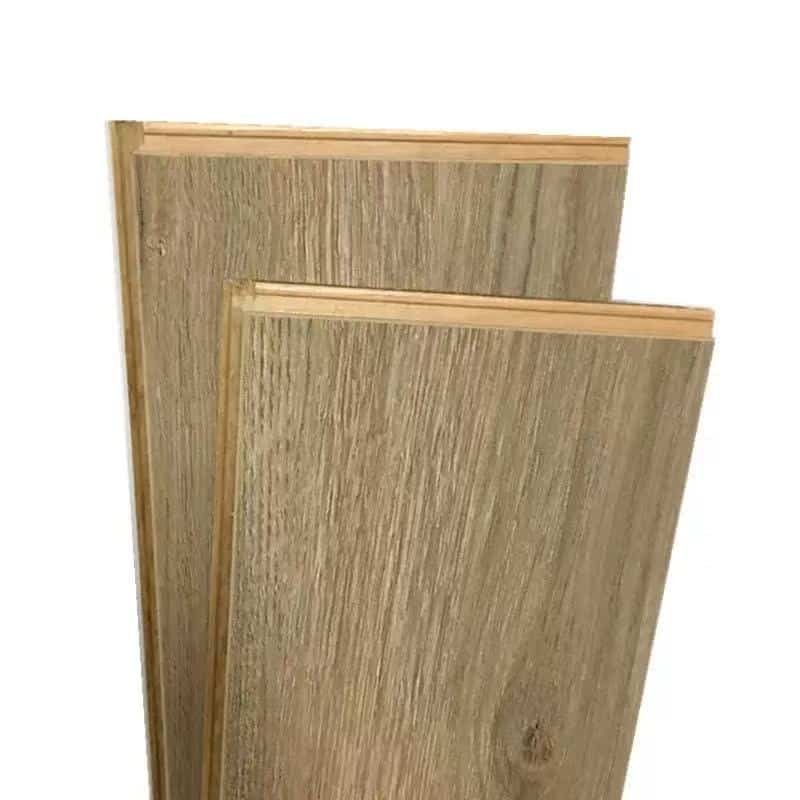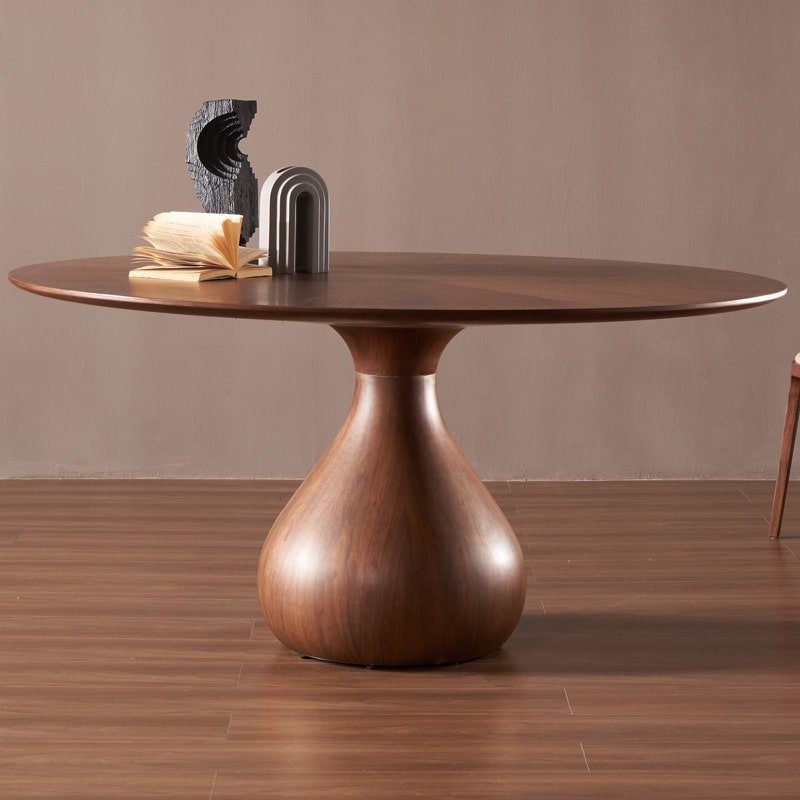This article aims to strip away the marketing trap and delve into the core issues of wood source and craftsmanship, directly addressing the core concerns of consumers: authenticity, price, and care. We hope to provide a calm and objective guide, allowing you to confidently choose a piece of solid wood furniture that will grow with your life and last forever.
Chapter 1: What is “Real” Solid Wood? — Insights from a Structural Perspective
The concept of “solid wood” is vague in the market. First, we must clarify the three main structural types:
Solid Wood/Pure Solid Wood Furniture:
Definition: All base materials are made from natural wood, joined only with mortise and tenon joints, hardware, and possibly glue. However, even in pure solid wood, different woods may be used for different parts (e.g., high-grade wood for the main panel and pine for the drawer panels).
Value: It best reflects the natural beauty of wood, is environmentally friendly and healthy, and has the potential to be collected and passed down.
Solid Wood Veneer Furniture:
Definition: The base material is a man-made board (such as MDF or particleboard), covered with a thin veneer of a valuable wood.
Key to identifying counterfeit furniture: Observe the cross-section of the board and the areas where holes and grooves are located. The cross-section of veneered furniture does not display a continuous wood grain, which is completely different from the surface texture.
Objective Evaluation: It is not inferior. It is highly stable, not prone to cracking or deformation, and can achieve the effect of a valuable wood grain at a low cost. However, environmental friendliness and durability depend on the quality of the base material and glue.
Finger-jointed/tooth-jointed furniture:
Definition: Furniture is made by joining small pieces of wood together using serrated joints to form large boards.
Key to identifying counterfeits: Visible signs of small joints and serrated joints are visible on the board surface.
Objective Evaluation: This is considered solid wood and is more environmentally friendly than engineered wood. It effectively utilizes scraps and offers a high cost-effectiveness. However, it lacks a visually cohesive feel and is slightly weaker than whole boards.
Key Conclusion: When purchasing, be sure to ask whether it is “pure solid wood” or “solid wood frame,” and request that the scientific name of the wood used in the main components be specified on the contract or order. Observing the back, interior, and cross-section of the furniture is the only way to distinguish authenticity.

Chapter 2: The Character Code of Wood – Performance and Applications of Common Materials
Different woods, like different personalities, have their own strengths and weaknesses. There’s no “best” wood, only the “most suitable” choice for you.
Wood Type: White Oak. Characteristics (Advantages): Hard and wear-resistant, with a bold, clear grain and corrosion resistance. A classic and durable choice. Weaknesses and Precautions: Can crack easily with improper care and is heavy. Ideal for heavy-duty furniture such as dining tables, chairs, and bookcases.
Wood Type: White Ash. Characteristics (Advantages): High hardness, excellent toughness, and easy to bend and shape. Has a rich, even grain. Weaknesses and Precautions: High price fluctuations and average insect resistance. Ideal for dining chairs (bentwood crafts), children’s furniture, and flooring.
Wood Type: Black Walnut. Characteristics (Advantages): The king of woods, with a calm color, beautiful grain, and excellent stability. Weaknesses and Precautions: Expensive, with large color variations, requiring careful selection. Ideal for cabinets, beds, and dining tables that showcase style. Wood Type: Cherry. Characteristics (Advantages): Soft texture, color changes from orange-red to deep red over time, creating a sense of life. Weaknesses and Considerations: The material is soft and easily scratched. Ideal for bedside tables, desks, display cabinets, etc.
Wood Type: Boxwood/Beech. Characteristics (Advantages): High hardness, fine grain, and uniform color. A cost-effective hardwood choice. Weaknesses and Considerations: Style leans towards traditional Chinese style. Ideal for chairs, bed frames, and structural support components.
Wood Type: Pine/Fir. Characteristics (Advantages): Soft texture, fresh color, and affordable price. Weaknesses and Considerations: It easily indents, has knots, and has a pine odor. Ideal for children’s furniture and country-style storage cabinets (often painted).
Chapter 3: Forging the Soul – Craftsmanship Details That Determine Longevity
Good wood is the foundation, good craftsmanship is the soul.
Structural Technique: Mortise and Tenon Joints vs. Hardware
Mortise and Tenon Joints: A culmination of traditional wisdom, they achieve connections through the concave and convex joints between wooden pieces. Advantages: Sturdy structure, prevents metal fatigue, extremely long life, and showcases the aesthetics of craftsmanship. Disadvantages: Requires high craftsmanship and is costly.
Modern Hardware: Uses metal fittings such as bolts and angle brackets for connection. Advantages: High production efficiency and convenient assembly and disassembly for transportation. Disadvantages: Risk of loosening with long-term use, requiring regular inspection and tightening.
Recommendation: Critical load-bearing areas (such as table legs and bed rails) should utilize mortise and tenon joints, or mortise and tenon joints combined with hardware reinforcement. Large cabinets can accept high-quality hardware connections.
Finishing Technique: Open vs. Closed
Open (Wood Wax Oil/Open Paint): The wood’s grain and pores are clearly visible, creating a natural finish. Wood wax oil is more environmentally friendly, but offers less protection and requires more frequent maintenance.
Sealed (thick lacquer/polyester lacquer): A smooth, thick film forms on the surface, completely covering the wood’s pores. Advantages: Water- and stain-resistant, easy to care for. Disadvantages: Can mask the wood’s true texture; inferior paint may pose environmental concerns.

Chapter 4: Rational Consumption and Avoiding Pitfalls – Common Problems and Ultimate Solutions
Q1: Why does solid wood furniture inevitably crack or warp? Did I buy a defective piece?
Expert Explanation: Slight cracking and warping are the “natural” nature of solid wood, not a quality defect. Wood “breathes” (expanding with heat and contracting with cold, expanding with moisture and contracting with drying) in response to changes in ambient temperature and humidity. Poor craftsmanship (such as substandard wood drying) or extreme operating environments (such as underfloor heating or direct air conditioning) can exacerbate this problem.
Solution:
When purchasing: Choose a reputable brand and ensure the wood has been properly dried (ideally, a moisture content of 8%-12%).
When using: Store the furniture away from heat sources and direct sunlight. Use a humidifier in winter and a dehumidifier or air conditioner in summer to maintain indoor humidity between 40% and 60%.
Daily Maintenance: Wipe regularly with a soft, dry cloth or use specialized maintenance oil/wood wax to replenish oil and reduce the risk of cracking.
Q2: How to deal with color variations in solid wood furniture?
Mindset Adjustment: Color variations and natural grain are the “identity card” of solid wood and the source of its unique beauty. Pursuing complete uniformity is like rejecting the laws of nature.
Purchasing Tips: If you prefer a uniform color, ask the seller to see photos of the entire collection at the time of purchase, or try to choose pieces from the same batch and block.
Q3: How to clean and repair scratches on solid wood furniture?
Daily Cleaning: Never use a damp cloth. Use a soft, semi-dry cloth, wiping along the grain, and immediately dry with a dry cloth.
Scratch Repair:
Shallow Scratches: Gently rub walnut kernels or a professional wood repair pen/paste into the scratch to effectively cover it.
Deeper Scratches: Use repair wax strips, melt the filler with a heat gun, and then scrape and sand.
Choosing a piece of furniture defines a life.
The value of solid wood furniture lies not in its price tag, but in its ability to carry your memories and accompany you as you grow. It transforms your home from a room of concrete to a warm, breathing space filled with stories.
Next time you choose something, please slow down, touch it with your hands, and feel it with your heart. May you find a living piece of furniture that speaks to you and is worth passing on to the next generation.


